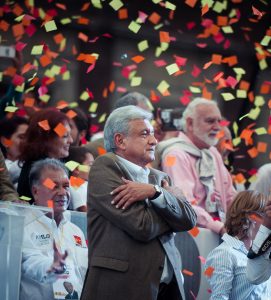 With the July 1 election of Andres Manuel Lopez Obrador (widely known by his initials, AMLO) as president, Mexico stands at a historic turning point, one that leaves Professor of Latin American Studies Miguel Tinker Salas cautiously optimistic about the prospect for real change.
With the July 1 election of Andres Manuel Lopez Obrador (widely known by his initials, AMLO) as president, Mexico stands at a historic turning point, one that leaves Professor of Latin American Studies Miguel Tinker Salas cautiously optimistic about the prospect for real change.
What’s Next For:
Revolutions?
Syria?
Mexico?
Japan?
The United States?
Earthquake Safety?
Climate Action?
California Water?
Climate Science?
Solar Energy?
California Fruit Farming?
Technology Investing?
Nanoscience?
Digital Storage?
Artificial Intelligence?
Cyber-Threats?
Social Media?
Space Exploration?
Science Museums?
The Sagehen?
Biodiversity?
The Blind?
Big Data?
Mental Illness?
Health Care Apps?
Maternity Care?
Etiquette?
Ballroom Dance?
Thrill Seekers?
Outdoor Recreation?
Funerals?
Writers?
Movies?
Manga?
Alt Rock?
Women in Mathematics?
“This represents a collapse of the existing political structure, led by the National Action Party [PAN] and the Party of the Institutionalized Revolution [PRI],” he explains. “It represents a rejection of their policies and of the U.S.-imposed war on drugs, and it speaks to the need most Mexicans feel for a fundamental change in their society.”
As an election observer, Tinker Salas says he saw blatant election fraud, but this time, the outrage over rampant corruption and desire for change were too strong for the two parties that have held power for the past 82 years to quash.
Among other things, AMLO has promised a major shift in the nation’s war on drugs—which has left more than 200,000 people dead and 30,000 disappeared in recent years—even proposing an amnesty for those not involved in violent crimes. He’s also pledged to defend Mexican immigrants in the U.S. and to revisit the controversial energy reforms of his predecessor. To show accountability, he’s vowed to offer himself up for a recall vote halfway through his six-year term.
Though AMLO has been labeled a leftist by his opponents, Tinker Salas believes the charge is bogus.
“Comparisons to Chávez in Venezuela or Correa in Ecuador or Morales in Bolivia are facile. They’re intended to inflame the political debate. AMLO was a member of the PRI, the dominant party. He attempted to reform the dominant party. Unable to, he joined other forces in forming the PRD, the Party of the Democratic Revolution, ran for office twice, with some very strong evidence of fraud against him.
“This time,” he adds, “indignation defeated fear.”
